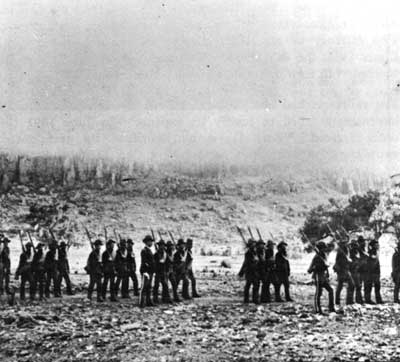|
FORT DAVIS National Historic Site |
 |

A staple of training during the peaceful years was the
practice march. Here a company of the 5th Infantry sets off from the
post. Officer in the center is Capt. Frank D. Baldwin.
Custer
(Little Bighorn) Battlefield National Monument, Mont.
Peace Comes to West Texas
AT THE HEIGHT OF THE CAMPAIGN against Victorio in the summer of 1880, General Ord had created the District of the Bravo out of the southern half of Grierson's District of the Pecos. The 1st Infantry had just arrived in Texas, and Ord appointed its colonel, William R. Shafter, to command the district. By the time Shafter reached Fort Davis, however, the campaign had ended. He once more took command of Fort Davis and stationed troops at a line of subposts along the Rio Grande from the mouth of the Pecos to old Fort Quitman. They occupied themselves in patroling the frontier to discourage remnants of Victorio's followers from entering the United States, built a new and shorter road (route of present U.S. 90) between San Antonio and Fort Davis, and protected construction parties of the Southern Pacific Railroad.

The Texas and Pacific and the Southern Pacific Railroads destroyed the Trans-Pecos frontier. Settlers and cattlemen arrived in increasing numbers. Indians no longer endangered the region. Outlaw gangs committed occasional robberies and murders, but these were the responsibility of the Texas Rangers. For its last decade as an active post, Fort Davis afforded its garrison a tranquil, routine existence of drill and instruction.
Colonel Grierson spent 3 pleasant years, 1882 to 1885, as post commander, occupying himself largely with a long campaign to win promotion to brigadier general. With his departure, the 18-year association of Negro regiments with Fort Davis drew to a close. The 3d Cavalry came in 1885 under Col. Albert G. Brackett, a veteran officer well known for his book, The History of the United States Cavalry. Under Col. Elmer Otis, the 8th Cavalry followed the 3d in 1887, to be succeeded in turn in 1888 by the 5th Infantry.
The railroads had both bypassed Fort Davis, and its utility increasingly failed to justify its expense. In June 1891 the order arrived. "Fort Davis had outlived its usefulness," wrote the department commander, Brig. Gen. David S. Stanley. "And yet it is to be regretted that it was discontinued, owing to its salubrious climate and its usefulness as a government sanitary hospital, to which enfeebled soldiers could be sent."
Across the road from Fort Davis a recently arrived rancher was building his new home. He probably watched Company F, 5th Infantry, turn over the post to a caretaker and march down the road to Marfa, to entrain for San Antonio. Brig. Gen. Benjamin H. Grierson, U.S. Army Retired, had come back to Fort Davis to take up the life of a cattleman.



By 1887, when these photographs were taken, the fort was at the
peak of its development. The top view is from Sleeping Lion Mountain. The T-shaped
buildings are barracks, the enclosed yards on the right are stables and corrals.
The bottom view is from the north; officers' row, on the right, and barracks flank the
parade ground. In the center photo appears the hospital and, left, the hospital
steward's house.
Denver Public Library (top), National Archives (center), Estate
of David S. Simmons (bottom)

|
|
Last Modified: Fri, Oct 18 2002 10:00:00 pm PDT |


